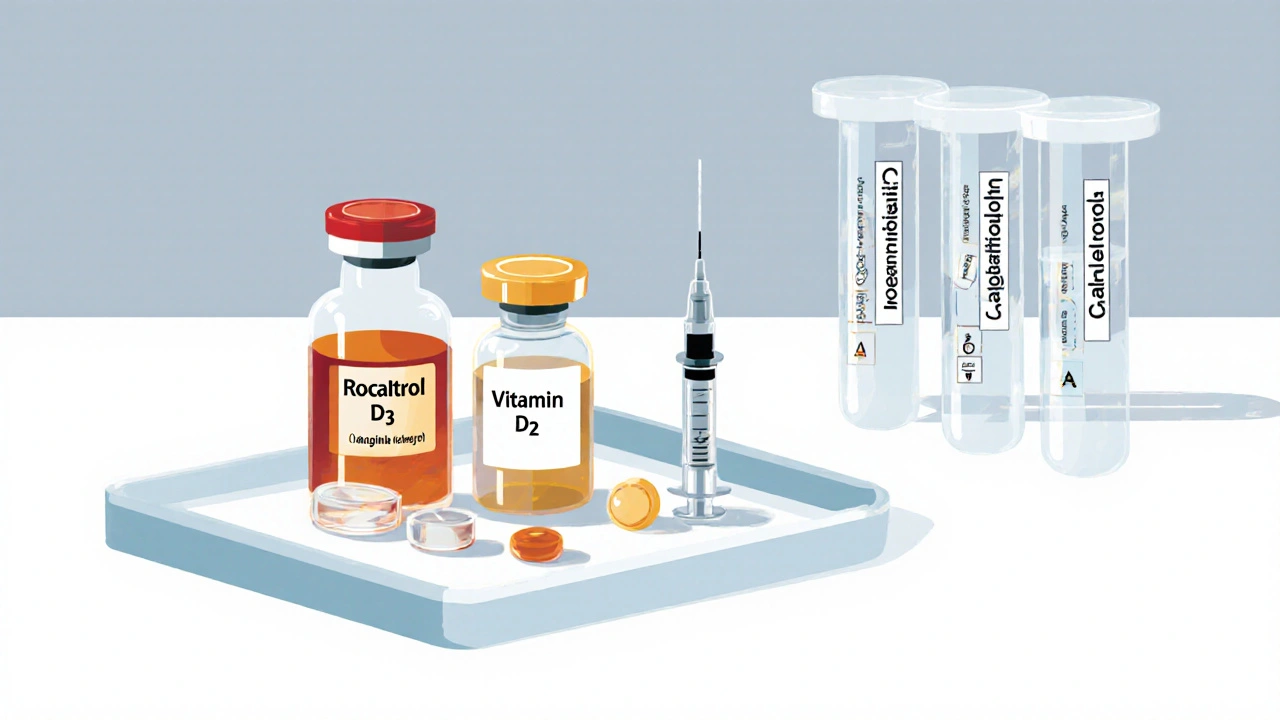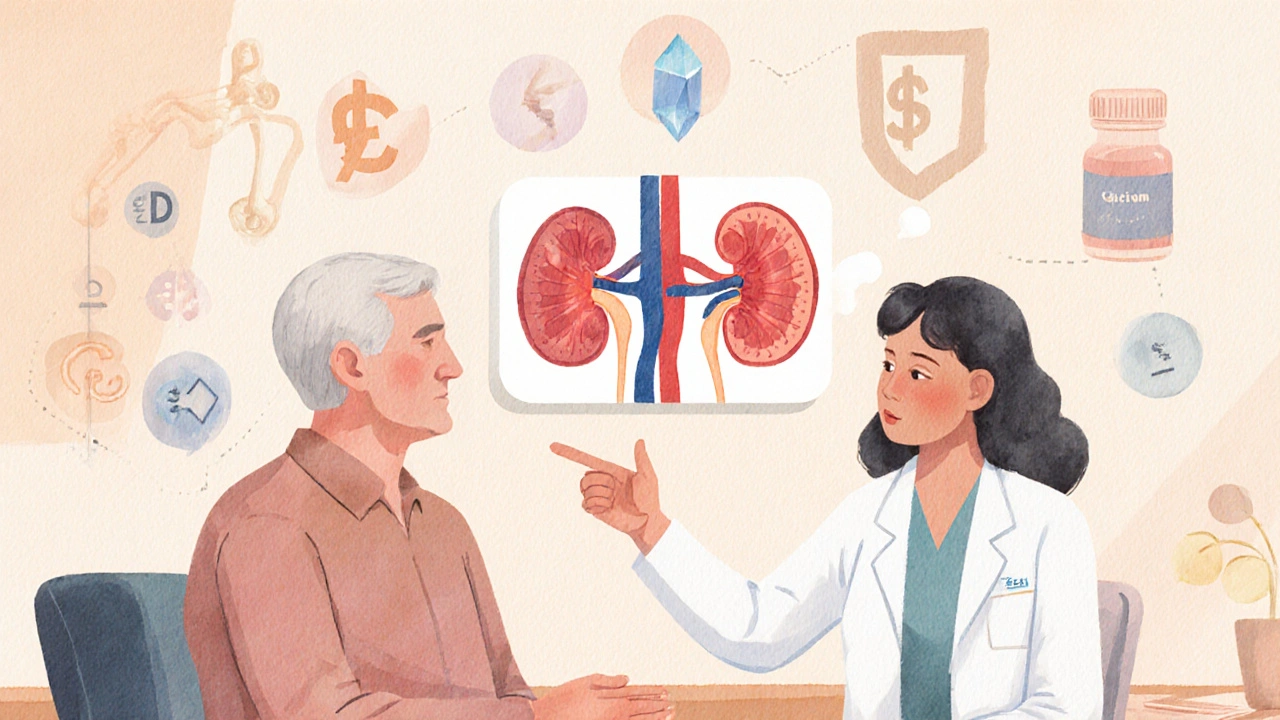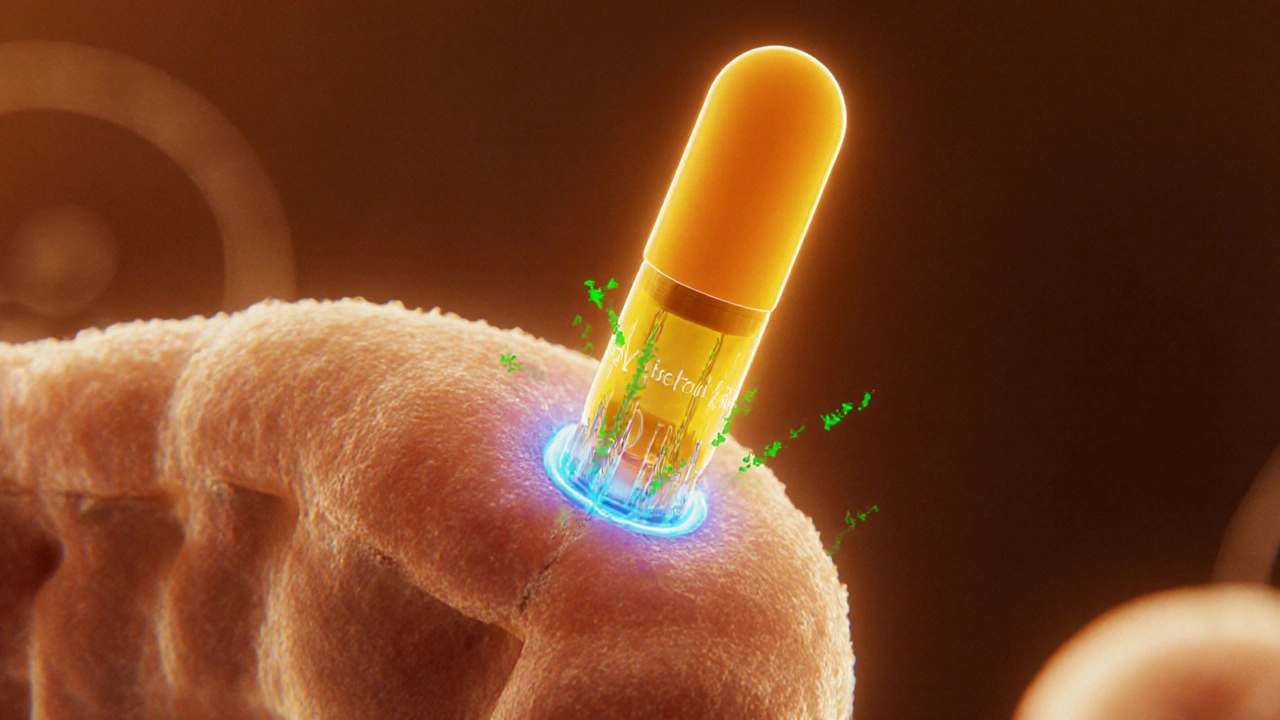Vitamin D Treatment Comparison Tool
Recommended Treatment Based on Your Inputs
Detailed Comparison
When doctors talk about vitamin D therapy, the name Rocaltrol often pops up, especially for patients with kidney‑related bone disorders. But it’s not the only option on the shelf. This guide walks through what makes Rocaltrol (calcitriol) unique, how it stacks up against the most common alternatives, and which factors should steer the final choice.
What is Rocaltrol (Calcitriol)?
Rocaltrol is a prescription medication that contains calcitriol, the active form of vitamin D. It works by directly binding to vitamin D receptors in the gut, bone, and kidneys, boosting calcium and phosphate absorption without needing conversion steps.
How does calcitriol work?
Calcitriol mimics the body’s natural hormone 1,25‑dihydroxy‑vitamin D. By activating the vitamin D receptor (VDR), it tells the intestines to absorb more calcium and phosphate, suppresses parathyroid hormone (PTH) release, and helps bone cells remodel properly. Because it’s already in the active form, it bypasses the liver and kidney conversions that regular vitamin D supplements require.
Who typically needs Rocaltrol?
Rocaltrol is most often prescribed for:
- Patients with chronic kidney disease (CKD) who can’t activate vitamin D on their own.
- Those suffering from secondary hyperparathyroidism (SHP) linked to CKD.
- Individuals with renal osteodystrophy - a bone‑mineral disorder caused by kidney failure.
In these settings, the drug helps normalize calcium levels, lower PTH, and reduce the risk of bone fractures.

Key considerations before starting Rocaltrol
Because calcitriol is potent, doctors keep an eye on several factors:
- Dosage: Starts low (often 0.25µg daily) and is titrated based on blood calcium and phosphate.
- Monitoring: Serum calcium, phosphate, and PTH are checked every 1‑2 weeks after dose changes.
- Side effects: Hypercalcemia (high calcium) is the main risk, which can cause nausea, weakness, and kidney stones.
- Cost: As a branded drug, Rocaltrol can be pricey without insurance coverage.
Major alternatives to Rocaltrol
Below are the most common drugs or supplements that clinicians consider when calcitriol isn’t ideal.
Cholecalciferol (vitamin D3) is the natural form of vitamin D produced in the skin after sun exposure. It requires two conversion steps-first in the liver to 25‑hydroxy‑vitamin D, then in the kidneys to the active form.
Ergocalciferol (vitamin D2) is plant‑derived vitamin D. Like D3, it must undergo liver and kidney activation, and its potency is slightly lower.
Doxercalciferol is an analog of calcitriol that also activates the VDR but has a slightly weaker calcium‑raising profile, making it a safer option for some CKD patients.
Paricalcitol is another synthetic vitamin D analog. It selectively suppresses PTH with a lower risk of hypercalcemia, often favored in advanced CKD.
Secondary hyperparathyroidism is a condition where the parathyroid glands overproduce PTH because the kidneys can’t keep calcium and phosphate in balance.
Chronic kidney disease describes the gradual loss of kidney function over months or years. As kidney function declines, the ability to convert vitamin D to its active form drops.
Renal osteodystrophy is a spectrum of bone disorders caused by the mineral imbalance in CKD, often presenting with bone pain, fractures, and abnormal bone turnover.
Side‑by‑side comparison
| Alternative | Mechanism | Typical Indication | Formulation | US Cost (approx.) | Monitoring Needs |
|---|---|---|---|---|---|
| Rocaltrol (calcitriol) | Active vitamin D analogue - directly binds VDR | CKD‑related SHP, renal osteodystrophy | Oral softgel 0.25‑0.5µg | $30‑$45 per 30‑day supply | Calcium, phosphate, PTH every 1‑2weeks when adjusting dose |
| Cholecalciferol (vit D3) | Pro‑hormone - needs liver & kidney activation | General vitamin D deficiency, osteoporosis prevention | Capsule 1000‑5000IU | $10‑$20 per 90‑day supply | Serum 25‑OH‑D annually; calcium rarely needed |
| Ergocalciferol (vit D2) | Plant‑derived pro‑hormone - liver & kidney activation | Similar to D3 but used in patients with vegan preferences | Capsule 1000‑5000IU | $12‑$22 per 90‑day supply | Serum 25‑OH‑D annually |
| Doxercalciferol | Vitamin D analogue - milder calcium‑raising effect | CKD‑associated SHP where hypercalcemia risk is high | Injectable 0.05‑0.25µg | $35‑$55 per 30‑day supply | Calcium, phosphate, PTH every 2‑4weeks |
| Paricalcitol | Selective VDR activator - suppresses PTH with lower Ca↑ | Advanced CKD, dialysis patients with SHP | Oral tablet 1‑5µg or IV 0.025‑0.05µg | $70‑$110 per 30‑day supply | Calcium, phosphate, PTH every 2‑4weeks |

How to choose the right option
Picking a therapy isn’t just about price or brand. Consider these decision points:
- Kidney function: If eGFR < 30mL/min, an active analog like calcitriol, doxercalciferol, or paricalcitol is usually required.
- Risk of hypercalcemia: Patients with a history of high calcium or kidney stones may benefit from paricalcitol or a low‑dose doxercalciferol instead of calcitriol.
- Insurance coverage: Many plans cover generic vitamin D3/D2 but not the prescription analogs. Check formulary tiers.
- Administration ease: Oral softgels (calcitriol, paricalcitol) are simpler than injectables (doxercalciferol).
- Target outcome: If the main goal is to raise 25‑OH‑D levels for overall bone health, D3/D2 are sufficient. For direct PTH suppression, an active analog wins.
In practice, doctors often start with calcitriol for moderate CKD, then switch to paricalcitol if calcium spikes become problematic.
Practical tips and common pitfalls
- Never combine high‑dose vitamin D3 with calcitriol without lab monitoring - the additive calcium load can be dangerous.
- Ask your pharmacist about generic equivalents; some compounding pharmacies offer a calcitriol powder that can be cheaper.
- Schedule blood work promptly after any dose adjustment; a missed test can mask rising calcium levels.
- For dialysis patients, coordinate with the nephrology team - they may already be giving IV paricalcitol during treatment.
- Stay hydrated; adequate fluid intake helps prevent calcium‑related kidney stones.
Frequently Asked Questions
What’s the difference between calcitriol and regular vitamin D supplements?
Calcitriol is the active hormone that the body normally makes from vitamin D. Regular supplements (vitamin D3 or D2) are precursors that need liver and kidney conversion. In kidney disease, that conversion is impaired, so calcitriol works instantly, while D3/D2 may never become fully active.
When is paricalcitol preferred over Rocaltrol?
Paricalcitol is chosen when the patient is prone to hypercalcemia or is on dialysis. Its selective action lowers PTH with less calcium increase, making it safer for those high‑risk groups.
Can I take over‑the‑counter vitamin D3 together with Rocaltrol?
Usually not recommended unless a doctor orders a specific low dose. Adding extra vitamin D can push calcium too high, leading to symptoms like nausea, weakness, or kidney stones.
How often should labs be checked after starting calcitriol?
Initial labs (calcium, phosphate, PTH) are drawn 1‑2weeks after the first dose, then every month until stable. After stability, quarterly checks are typical.
Is calcitriol covered by Medicare or private insurance?
Coverage varies. Medicare Part D often lists calcitriol under specialty drugs, so a prior authorization may be needed. Private plans may cover it if prescribed for CKD‑related SHP; checking the formulary is essential.
What are the signs of hypercalcemia I should watch for?
Common symptoms include nausea, vomiting, excessive thirst, frequent urination, muscle weakness, and confusion. If any appear, contact a healthcare provider right away and get labs checked.

Julia Gonchar
October 10, 2025 AT 00:46Rocaltrol is basically calcitriol, the active form of vitamin D, so it bypasses the liver’s conversion steps. That means it can be a game‑changer for patients with severe kidney issues who can’t make enough of the hormone on their own. The downside? It’s pricier and you have to watch calcium levels like a hawk to avoid hypercalcemia. Bottom line: for the right subset of folks, it’s worth the extra monitoring.
Annie Crumbaugh
October 12, 2025 AT 22:13Sounds like a solid tool for those with low kidney function.
KISHORE KANKIPATI
October 15, 2025 AT 19:39Imagine your body as a bustling marketplace, and vitamin D is the charismatic vendor shouting about calcium supplies. Rocaltrol steps in as the seasoned merchant who already pre‑packed the goods, saving the tired stalls from crafting the product themselves. In contrast, standard D2 or D3 supplements are like raw ingredients waiting for the kitchen staff-your liver and kidneys-to whip them into shape. When those chefs are on strike, you need the ready‑made feast, otherwise you might end up with an empty pantry. So the choice really hinges on whether your internal kitchen is fully staffed or running on fumes.
Jefferson Vine
October 18, 2025 AT 17:06They don’t tell you in the brochures that pharma pushes Rocaltrol to keep you hooked on lab tests-it's the perfect surveillance loop! Use it wisely, and you stay ahead of the hidden agenda.
Ben Wyatt
October 21, 2025 AT 14:33Rocaltrol (calcitriol) is the hormonally active form of vitamin D, which means it doesn’t require the kidneys to convert it from an inactive precursor. This makes it especially useful for patients with chronic kidney disease (CKD) who have a reduced estimated glomerular filtration rate (eGFR). In those cases, conventional vitamin D supplements like cholecalciferol (D3) or ergocalciferol (D2) often fail to raise serum 1,25‑(OH)₂ D levels sufficiently. By delivering the active hormone directly, Rocaltrol can more reliably correct secondary hyperparathyroidism, a common complication in CKD. However, the potency of calcitriol also brings a higher risk of hypercalcemia and hyperphosphatemia if dosing isn’t closely monitored. That’s why clinicians typically start with low doses, such as 0.25 µg daily, and adjust based on calcium, phosphorus, and PTH labs. In contrast, standard D3 supplements are cheap, widely available over the counter, and generally safe for people with normal kidney function. They rely on hepatic 25‑hydroxylation and renal 1α‑hydroxylation to become active, so they’re ineffective when the latter step is impaired. For patients with mild kidney impairment (eGFR 45‑59 mL/min), many doctors still prefer high‑dose D3 because the kidneys retain enough conversion capacity. When the eGFR drops below 30 mL/min, the conversion curve flattens dramatically, and that’s when guidelines start recommending calcitriol or its analogs. The analogs, such as alfacalcidol or paricalcitol, have slightly different binding affinities and may cause fewer calcium spikes, offering another option. Cost is another practical consideration: Rocaltrol is prescription‑only and can be several times more expensive than a bottle of generic D3. Insurance coverage varies, and some plans require prior authorization, which adds administrative burden for both patients and providers. Regardless of the formulation, adherence to therapy hinges on clear patient education about potential side effects and the importance of periodic lab checks. If patients understand why calcium levels are being monitored, they’re more likely to report symptoms early and avoid complications. Bottom line: choose the form of vitamin D that matches the patient’s kidney function, comorbidities, and ability to follow up with labs-Rocaltrol for advanced CKD, D3 for the rest, and always keep an eye on calcium and phosphate.
Donna Oberg
October 23, 2025 AT 08:13Wow!!! Rocaltrol sure sounds like the VIP pass for those with busted kidneys, but don’t forget-every VIP needs a bodyguard, aka regular calcium labs; otherwise you’re playing with fire!!! Make sure your doc runs those tests before and after you start-seriously, it’s not optional!!!
Garreth Collard
October 25, 2025 AT 01:53In the grand theatrical production of endocrinology, calcitriol takes the lead role while cholecalciferol dutifully plays the understudy. One cannot simply dismiss the star’s impact on mineral homeostasis, yet the supporting cast of analogs adds nuance to the plot. Appreciating this layered performance requires a discerning palate, not merely a casual glance at the label.
Quinn Comprosky
October 26, 2025 AT 05:39Fair point, Donna. The labs are the real safety net, especially since hypercalcemia can sneak up with subtle symptoms like fatigue or nausea. I’ve seen patients miss that step and end up in the ER, which is avoidable with diligent monitoring.
sourabh kumar
October 28, 2025 AT 13:13calcitriol works fast but watch calcium levels its important
Christian Miller
October 29, 2025 AT 16:59It is worth noting that the pharmaceutical supply chain for calcitriol is tightly controlled, fostering reliance on proprietary formulations that limit generic competition. This dynamic subtly steers prescribing habits toward more profitable, brand‑specific products, a fact often obscured in standard clinical guidelines.
NORMAND TRUDEL-HACHÉ
November 1, 2025 AT 00:33Honestly, if you’re not dealing with stage‑IV CKD, reaching for Rocaltrol is like using a sledgehammer to crack a walnut. Stick with D3, save the wallet, and keep the labs in check.
AJIT SHARMA
November 2, 2025 AT 04:19These vitamin D debates get overblown. At the end of the day, most people just need sunlight and a cheap supplement. The hype around Rocaltrol feels like a cash‑grab.
Neber Laura
November 4, 2025 AT 11:53Stop ignoring the data! Studies show calcitriol spikes calcium faster than any over‑the‑counter D3. If you’re not prepared to monitor, you’re courting danger.
Karen Nirupa
November 5, 2025 AT 15:39From a global health perspective, accessibility to affordable vitamin D sources remains a challenge in many regions. While Rocaltrol offers therapeutic precision for renal patients, it underscores the disparity between high‑income healthcare systems and underserved populations that rely on sunlight and basic supplementation.
Quinn Comprosky
November 7, 2025 AT 23:13I completely understand why the distinction between calcitriol and regular vitamin D can feel overwhelming, especially when you’re juggling multiple health concerns. The key is to align the treatment with the underlying renal function, because the body’s ability to activate vitamin D changes dramatically as eGFR declines. If you’re in the early stages of kidney disease, a high‑dose D3 might be sufficient, but once you cross the threshold where the kidneys can’t hydroxylate the precursor, calcitriol becomes the logical step. Always keep an open line of communication with your nephrologist, and don’t hesitate to ask for a clear monitoring schedule so you stay ahead of any potential side effects.
Thomas Ruzzano
November 9, 2025 AT 02:59Let’s be real, most people jump on the Rocaltrol hype without checking their actual calcium labs first. If you’re not borderline hypercalcemic, why risk a prescription drug that costs three times more than a bottle of D3? Save yourself the hassle and stick to what works for the majority.
Dan Tenaguillo Gil
November 11, 2025 AT 10:33When guiding patients through the maze of vitamin D therapy, it’s essential to frame the conversation in terms of both efficacy and accessibility. Calcitriol offers a direct route to the active hormone, which is invaluable for those whose kidneys can’t perform the final activation step, but it also demands a higher level of clinical oversight. By contrast, cholecalciferol is inexpensive, widely available, and sufficient for individuals with intact renal conversion pathways, making it a pragmatic first‑line option in many settings. Encouraging shared decision‑making, where we discuss the trade‑offs of cost, monitoring frequency, and potential side effects, empowers patients to take ownership of their treatment plan. Ultimately, the best choice is the one that aligns with the patient’s clinical status, resources, and willingness to engage in regular follow‑up.
Tiffany Owen-Ray
November 12, 2025 AT 14:19Think of vitamin D as the sunlight of your inner world; sometimes you need to harness it directly, other times you can rely on the gentle glow of a supplement. Rocaltrol is that concentrated beam for those whose bodies can’t capture the sun on their own, while D3 is the ambient light that nourishes most of us. Trust your body’s signals, stay curious, and remember that balance, not extremes, leads to lasting health.
Kate Taylor
November 14, 2025 AT 21:53From a pharmacokinetic standpoint, calcitriol exhibits a rapid onset of action due to its direct receptor affinity, bypassing the hepatic 25‑hydroxylation step required for ergocalciferol. Consequently, plasma 1,25‑(OH)₂ D concentrations rise sharply, necessitating vigilant iPTH and serum calcium surveillance to mitigate iatrogenic hypercalcemia. In contrast, cholecalciferol’s bioavailability is modulated by adipose tissue sequestration, resulting in a more protracted elevation of 25‑OH D levels. Thus, therapeutic selection should be predicated on renal hydroxylase capacity, baseline mineral indices, and patient adherence potential.
Hannah Mae
November 16, 2025 AT 01:39All this talk makes me think we’re overcomplicating something simple – just get some sunshine and a cheap D3, no need for fancy Rx.